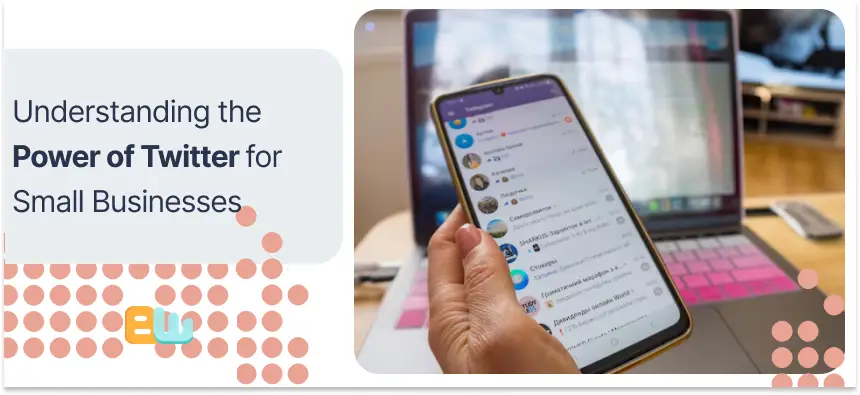
In today’s digital world, having a solid online presence is very important for all businesses, big or small. A good Twitter marketing strategy helps create brand awareness and connect with your target audience. This article will give small businesses the tools and knowledge to use Twitter well and compete with more prominent brands.
Understanding the Power of Twitter for Small Businesses

Twitter has become an essential player in social media marketing. Its easy-to-use design is a strong marketing tool, especially for small businesses. With millions of active users, Twitter offers a special place to connect with potential customers and join in on important industry talks.
The platform’s real-time aspect helps businesses respond quickly to customer questions, building trust and loyalty. Small companies can compete better and see growth by learning how Twitter works and using innovative strategies.
Why Twitter is a key player in digital marketing
Twitter is a powerful tool for businesses. It helps them reach a wider audience and make their marketing efforts more effective. Twitter’s short format makes it easy to share posts, which can help content go viral and reach more people without needing a lot of money. Also, Twitter lets small businesses compete with bigger brands for attention.
What makes Twitter special is that it allows businesses to connect in real-time. Businesses can join conversations, answer questions, and discuss industry topics. This helps them show they know their stuff and connect with potential customers.
The impact of Twitter on brand visibility and customer engagement
Twitter is a great way to boost brand awareness and connect with customers. Businesses can become leaders in their field and build a solid online presence by engaging in conversations, sharing valuable content, and discussing industry topics.
Twitter is also a good customer service tool. Quickly answering customer questions and fixing issues in public shows that you care about customer satisfaction. This helps build a good brand reputation and trust with potential clients.
Businesses can also use Twitter’s features, such as polls, Q&A sessions, and live chats. These tools create interactive experiences that resonate with their audience, increasing brand awareness, stronger customer loyalty, and business growth.
Preparing Your Small Business for Twitter

Before jumping into Twitter, it’s important to prepare yourself for success. This means making a clear plan, knowing your target audience, and getting the right tools. Planning can help your Twitter efforts achieve the results you want.
Create a great Twitter profile that showcases your brand and appeals to your target audience. Learn about Twitter’s features and functions to maximize its potential.
Essential tools and resources for starting on Twitter
Starting a Twitter account can feel hard, but many tools and resources can make it easier. These tools can help you with your social media work. Consider using:
- Social listening tools: For example, Sprout Social helps track mentions of your brand, find out what customers are feeling, and follow important industry trends.
- Scheduling and automation tools let you plan your tweets, allowing you to post regularly without logging in all day.
- Analytics platforms: Twitter has an analytics tool that provides useful insights into your performance. Other platforms can provide even more detailed information to help you improve your strategies.
Creating a compelling Twitter profile that stands out
Your Twitter profile is the first place potential customers see. Creating an exciting Twitter presence that makes a strong impression is very important.
Choose a catchy Twitter handle that matches your brand. Use clear, high-quality images for your profile picture and header. These should fit with your brand’s style. Also, write a short but informative bio showing what your brand offers and your business is all about.
Identifying your target audience on Twitter

Understanding your target audience is very important. It helps you create messages that connect with people and get desired results. To find your target audience on Twitter, you need to look into their age, interests, habits, and how they engage online.
Start by examining your current customers. Look at your competitors, too. See what similar traits and interests their Twitter followers have. You can use Twitter’s search tools and check social listening tools to find conversations about your industry. This will help you gather valuable insights into the interests and challenges of your potential customers.
Setting realistic goals and objectives for your Twitter presence
Establishing clear and realistic goals is essential for improving your Twitter marketing efforts. Decide what you want to achieve. This could be increasing brand awareness, getting visitors to your site, or generating leads. Set SMART goals that are specific, measurable, achievable, relevant, and timed. This will help guide your strategy.
Next, find the key performance indicators (KPIs) that match your overall business goals. Track your progress regularly. Monitor metrics like engagement rate, link clicks, website referrals, and conversions. Avoid focusing on vanity metrics like follower count.
Step-by-Step Guide to Tweeting for Business Success

Tweeting for business success requires a smart plan based on consistency, user engagement, and data analysis. A clear guide can help you use Twitter better and reach your goals.
From creating interesting posts to using analytics, every step is important for a strong and effective Twitter strategy.
Step 1: Building a content calendar for consistent tweeting
Maintaining a regular tweeting schedule is important. It helps you reach more people and keeps your audience interested. Making a content calendar can help you plan your tweets ahead of time. This way, you ensure a steady flow of valuable content and lower the chances of being inconsistent.
A good content calendar should have:
- Different types of content: Use text tweets, images, videos, GIFs, polls, and questions. This keeps your audience engaged and meets their different preferences.
- Relevant hashtags: Look for and add relevant hashtags. This expands your reach and makes your tweets easier to find for a wider audience interested in your field.
- Best times to post: Plan your tweets for the best times when your target audience is active. This enhances visibility and gets more interaction.
Step 2: Engaging with followers and influencers to expand your reach
Engagement is critical for a good Twitter strategy. When you actively engage with your followers, you can reach more people and share your message better. Quickly responding to comments and mentions shows you care about your audience’s thoughts. This helps create a community feeling.
Working with influencers in your area can help you reach a wider audience and give your brand more credibility. Look for influencers who share your values. You can also look for opportunities to promote each other or partner up.
You build strong connections by participating in conversations, asking questions, and creating fundamental interactions. This helps you form a loyal and engaged community around your brand.
Step 3: Monitoring mentions and feedback to improve customer service

Monitoring what people say about your brand helps provide good customer service and gives valuable insights into how consumers feel. To monitor brand mentions well, you should:
- Use social listening tools: Tools like Sprout Social track brand mentions on Twitter. This lets you quickly respond to customer questions and fix issues.
- Set up search streams: Make different search streams for your brand name, important keywords in your industry, and your competitors. This keeps you up-to-date on discussions that matter and helps you find new chances.
- Analyze sentiment: Don’t just notice mentions. Look at what people feel about them. Understanding customer comments, whether good or bad, helps you shape your products or services and makes customers happier.
Step 4: Utilizing Twitter ads for targeted promotions
While organic reach is important, Twitter Ads can help improve your marketing efforts. They can focus on specific groups of people. These ads can help you:
- Promote your profile: You can get more followers and draw in new leads by targeting users who share interests with your current followers.
- Boost engagement: Share your best tweets to reach a wider audience.
- Drive traffic to your website: Use website cards or app install cards to guide people from your tweets to specific pages.
Advanced Twitter Tactics for Sustained Growth

To grow long-term on Twitter, you must be flexible and ready to change your plans. Keep up with the latest features and try out new tools. This can help you stay ahead of others.
By regularly updating your strategy, you make sure your work on Twitter is interesting and important. This helps you continue to grow and succeed.
Exploring Twitter’s latest features for businesses
Twitter is always changing. It adds new features and updates that can greatly affect your business marketing strategy. It is important to keep up with these new features. Doing so helps you reach more people and improve your profile.
Check out new features like Twitter Spaces. They let you talk to your audience through live audio chats. You should also think about using Twitter Fleets. This is temporary content that goes away after 24 hours. It adds a sense of exclusivity and urgency to your messages.
Integrating Twitter with other social media platforms for a unified strategy
Twitter is a strong platform, but you can improve it by linking it with your other social media accounts. This way, you create a smooth and consistent brand experience for your audience.
Promote your Twitter profile on your website, in your email signature, and on other social media platforms. This will help bring more people to your Twitter page and boost your visibility. You can also share a brief summary of your Twitter posts on Instagram Stories or Facebook. This will encourage your audience to interact with you on different platforms.
Conclusion
In conclusion, Twitter is a great place for small businesses to compete with big companies. By using Twitter well, you can improve your brand visibility, connect with customers, and see significant growth.
Create an interesting profile, know your target audience, set clear goals, and stay active to build a strong presence. Use the right tools, monitor feedback, and run focused promotions to succeed. Stay aware of new features and connect Twitter with other platforms for a complete strategy. With hard work and smart tweeting, small businesses can do well online.
